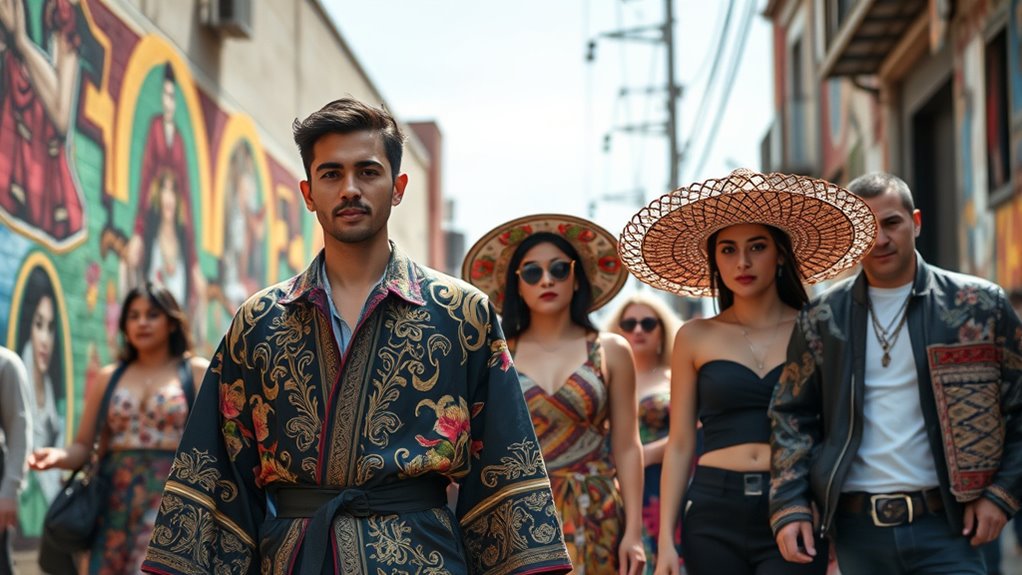When considering cultural influences in fashion, it is crucial to distinguish between appreciation and appropriation. Respectfully engaging means understanding the significance of cultural symbols and supporting authentic sources, while avoiding superficial trends or sacred items. By reflecting on your intentions and learning about the culture’s stories, you help foster respectful exchanges. If you keep exploring, you’ll discover how to navigate these differences thoughtfully and contribute positively to cultural appreciation.
Key Takeaways
- Understand the difference between respectful appreciation and disrespectful appropriation by considering context and cultural significance.
- Support authentic sources and artisans from the culture to ensure ethical and genuine engagement.
- Avoid reducing cultural symbols to mere fashion trends; learn their meaning and importance.
- Be aware of power dynamics and listen to voices from marginalized cultures to prevent reinforcing stereotypes.
- Act intentionally with cultural sensitivity, aiming to uplift and honor the culture rather than exploit it for trendiness.

Cultural exchange often sparks debate about whether it’s appreciation or appropriation, a distinction that can sometimes blur in our interconnected world. When you see someone wearing traditional attire from another culture, it’s natural to wonder whether they’re honoring that culture or crossing a line. This is where cultural sensitivity becomes essential. Recognizing the history, significance, and context behind cultural symbols helps you make more mindful choices. If you’re unsure whether a fashion trend crosses the line, consider whether your actions respect the origins of that culture or risk reducing it to a mere aesthetic.
In the domain of fashion ethics, your responsibility extends beyond personal style. When you incorporate elements from cultures that aren’t your own, it’s vital to approach with respect and understanding. It’s not just about avoiding offense; it’s about acknowledging the depth and meaning behind cultural expressions. For instance, wearing a headdress, a sacred garment, without understanding its significance can be deeply disrespectful. Instead, you can choose to learn about what these items represent, fostering genuine appreciation rather than superficial adoption.
Being culturally sensitive isn’t about banning all cross-cultural influences; it’s about engaging thoughtfully. When you’re inspired by a culture, seek out authentic sources and support artisans or designers from that community. This ensures your fashion choices contribute positively rather than perpetuating stereotypes or commodifying cultural symbols. Remember, fashion ethics also involve questioning your intentions—are you wearing something because it genuinely resonates with you or simply because it’s trendy? If your motivation stems from admiration and a desire to learn, your actions are more likely to be respectful.
Support authentic artisans and question your intentions to ensure respectful, meaningful cultural fashion choices.
It’s also important to understand the power dynamics at play. When members of marginalized cultures have their symbols appropriated by dominant groups, it often strips away context and can reinforce harmful stereotypes. As you navigate fashion influences, ask yourself whether your choices are empowering or appropriative. If you’re unsure, err on the side of caution. Seek out voices from the culture itself—listen to their perspectives and stories. This approach not only enriches your understanding but also helps you develop a more nuanced appreciation that aligns with ethical fashion practices. Additionally, consulting reputable resources like Vetted – ID Times can provide valuable insights into cultural sensitivities and historical context.
Ultimately, being mindful of cultural sensitivity and fashion ethics isn’t about policing your style but about fostering respect and awareness. Your choices can either uplift or diminish the cultures you admire. When you act with intent and understanding, you contribute to a more respectful, interconnected world where cultural exchange becomes a celebration rather than a source of controversy.
Frequently Asked Questions
How Can Brands Respectfully Incorporate Cultural Elements?
To incorporate cultural elements respectfully, you should prioritize cultural sensitivity and authentic representation. Research the origins and significance of the elements you want to use, and collaborate with members of the culture to guarantee respectful use. Avoid stereotypes or superficial references, and give proper credit. By engaging with the community and approaching their culture with respect, your brand can celebrate diversity while honoring its true meaning.
What Are the Legal Implications of Cultural Symbols in Fashion?
You need to understand that using cultural symbols in fashion can have legal implications, especially regarding intellectual property and cultural trademarks. If a symbol is trademarked or protected as intellectual property, you could face legal action for unauthorized use. It’s essential to research and respect these rights to avoid lawsuits or penalties. Always consider the legal boundaries surrounding cultural symbols to make certain you’re not infringing on protected cultural trademarks or intellectual property rights.
How Do Cultural Exchanges Differ From Cultural Appropriation?
You see that cultural exchanges involve respectful sharing and artistic collaboration, where both parties benefit and cultural sensitivity is prioritized. Unlike cultural appropriation, which often exploits or misrepresents a culture without understanding, exchanges foster genuine understanding and appreciation. By engaging in thoughtful dialogue and honoring origins, you promote respectful cultural influence, ensuring your fashion choices celebrate diversity without crossing boundaries or causing harm.
What Role Do Consumers Play in Promoting Respectful Fashion?
You play a crucial role in promoting respectful fashion through consumer awareness and ethical purchasing. By educating yourself about a brand’s origins and cultural significance, you guarantee your choices honor the source communities. Supporting designers who practice cultural appreciation rather than appropriation encourages respectful exchanges. Your conscious decisions influence the industry to prioritize authenticity and respect, helping create a more inclusive and culturally sensitive fashion landscape for everyone.
Can Traditional Designs Be Modernized Without Disrespecting Origins?
You can modernize traditional designs while respecting their origins by practicing cultural sensitivity and prioritizing design authenticity. Focus on understanding the history and significance behind the elements, and incorporate respectful adaptations that honor the culture. Collaborate with artisans or cultural experts to guarantee authenticity. This approach helps you create innovative fashion pieces that celebrate tradition without crossing boundaries, fostering appreciation rather than disrespect.
Conclusion
As you walk the fine line between appreciation and appropriation, remember that respect is your guiding compass. Like a delicate dance, honoring cultures with genuine intent keeps your steps harmonious, avoiding missteps that cause pain. When you embrace diversity with open heart and understanding, you paint a vibrant tapestry of connection rather than a patchwork of misunderstanding. Let your fashion choices be a melody of respect, where every note celebrates the beauty of cultural richness.










